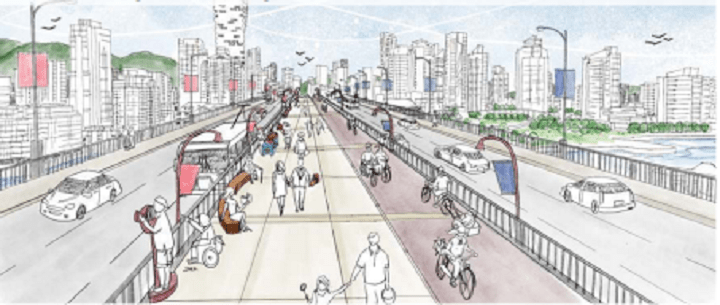Vancouver’s Granville Bridge is getting a major facelift, and the city is asking residents to weigh in on the final design.

The city has already begun seismic upgrades to the span, and is proposing major changes to the bridge that would make it more accessible to pedestrians and cyclists.
The city says the bridge was originally designed for high-volume freeways which were never built, and its eight car lanes are operating significantly below capacity.
A report to council in January made the case for a separated cycling and pedestrian route down the centre of the bridge, which it said would be the most cost-effective option and avoid problems with the bridge’s ramps and the Granville Loops at its north end.
The city conducted a preliminary round of consultations in the spring which Paul Storer, Vancouver’s manager of transportation design, said was clear on one point.
“The biggest message we heard is that something needs to be done. Nobody likes how walking and cycling work across that bridge and that there’s lots of opportunities for improvement,” he said.
“We overwhelmingly heard support for the project as a whole.”
WATCH: Bike lanes playing large part in redesign plans for the Granville Bridge (Aired: Jan. 24, 2019)

We’re now getting a clearer picture of what the final upgrade could look like: the city has unveiled six proposed designs, all of which propose the elimination of two lanes of vehicle traffic.
You can see a detailed breakdown of all options, along with the city’s assessment of pros and cons of each here.
The public is being asked to weigh in on the design options at a series of open houses in September, or through an online survey, which opens on Sept. 13 and runs to the end of the month.
- Big B.C. election promises from both frontrunners mean big spending ahead
- Deal with BC Hydro could spare northern B.C. community millions to fix water quality
- ‘I ain’t stopping for no red light,’ said B.C. hit-and-run driver before deadly crash
- BC NDP say housing speculation tax working, pledge to double it
The city will review feedback over the fall, with a council decision expected in early 2020. Construction would begin in 2021, pending approval and the development of a detailed plan.
Option 1: West Side
Option 1 would see a wide sidewalk and a two-directional bike path built on the bridge’s west side. The east sidewalk would be left as-is.
The city would install new traffic signals at the Howe and Fir ramp crossings.
Option 1 comes with an estimated price tag of $20 million to $30 million.
Users of the new path would access the bridge from Granville Street itself.
Option 2: West Side +
Like Option 1, Option 2 would see a wide sidewalk and a bi-directional bike lane on the west side of the bridge.
It would also see the widening of the sidewalk on the east side of the bridge.

Get breaking National news
Pedestrians and cyclists could access the bridge from Granville Street, while a second pedestrian access point would be upgraded on the Hemlock ramp and a flatter cycle route would be added on the Fir ramp.
Traffic lights would also be added at the Howe and Fir ramp crossings.
Option 2 is estimated to cost between $30 million and $40 million.
Option 3: East Side
Option 3 essentially inverts Option 1. It would see a wide, two-directional bike lane on the east side of the bridge and leave the west sidewalk as is.
Traffic signals would be added at the Hemlock and Seymour ramp crossings.
The city says crossings on the east side could force more traffic onto Granville street downtown. This option could also limit the ability to prioritize northbound transit.
Option 3 is estimated to cost between $20 million and $30 million.
Option 4: East Side +
An inversion of Option 2, Option 4 includes a wide sidewalk and a two-directional bike lane on the east side of the bridge, along with an upgraded sidewalk on the west side.
Both cyclists and pedestrians could access the bridge from Granville Street. An improved pedestrian route would be added to the 4th Avenue ramp, and an improved and flatter bicycle access point would be added to the Hemlock ramp.
Traffic signals would be installed at the Hemlock and Seymour ramp crossings, which the city said could cause traffic volume to accumulate around Hemlock Street.
Option 5: Raised Centre
A version of Option 5 was already floated earlier this year. The concept would see the creation of a wide sidewalk and two-directional bike route down the centre of the bridge.
The path would be elevated by about one metre to give better views and to separate it from traffic.
The existing east and west sidewalks would be left as-is. Most users would access the bridge from Granville Street at both ends.
This option would eliminate the need for traffic signals at either end of the bridge, and users would not need to cross a lane of traffic to access it.
However, it has poorer water views, and comes with less public space than the east and west side options.
It is also significantly more expensive, with a price tag of between $45 million and $55 million.
Option 6: Both Sides
Option 6 would see existing sidewalks on both sides of the bridge widened.
Each side would see the addition of a new one-directional cycle path, similar to the Burrard Bridge.
This option would require users to cross a lane of traffic at each end, necessitating the addition of four traffic signals.
It would allow water views from both sides of the bridge, and connect to existing sidewalks on 4th Avenue, Fir, Hemlock, Howe, and Seymour ramps.
But the city says it would include significantly less space for seating or other public uses, could feed extra traffic onto Granville Street and has poor potential for transit priority.




















Comments